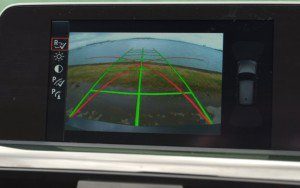The history of reversing sensors and reversing cameras
Reversing cameras and reversing sensors have been conceptualised on vehicles since before 1950. The first sensors were simple kerb sensors which gradually grew in sophistication through to the 1980s. These consisted of a flexible wand which triggered an audible signal inside the vehicle when it came into contact with a kerb.
But it was hardly a proper reversing sensor; more of a parking aid. True reversing sensors need to scan behind the car and warn the driver if there’s an obstacle. Manufacturers had trialled a number of systems in the 1970s and early ‘80s.
- Laser: worked well, but in a very narrow beam meaning that they could easily miss posts that could damage bumpers
- Ultrasound: far too sensitive to atmospheric conditions (especially wind and rain) and other noise can affect them
- Infrared: suffered from bad reflections and absorption
- Cameras: far too expensive, even though they had first been demonstrated on a Buick Centurion concept car in 1956.
Microwave-based systems worked most reliably, though. The first patent for one was filed in 1983, but it wasn’t until the mid-1990s that 7 Series BMWs began to feature them. Cameras also debuted in a production car with the Toyota Soarer and Infiniti Q45.
Modern systems have become more advanced as technology has become cheaper. Many cars come with a either a reversing camera, sensors (often with graphical overlays or representations on a display, like the VW Golf in this image), or both. Sensors are often added to the front of more expensive vehicles.
More recently, vehicles that have self-parking technology and blind spot warning systems have used sensors on the side of the cars.
Advantages of reversing cameras
Safety
Many vehicles have a particularly high boot line with a small rear window. Large SUVs like BMW’s X5 and compact SUVs like Hyundai’s ix35 are one of many examples of cars that are already at a disadvantage by being taller, but also have minimal visibility and thick rear pillars. When reversing out of a driveway, for example, it would be difficult to see a toddler playing behind the car. This is a scenario that kills many children every year, and one that is virtually eliminated with a reversing camera.
Visibility and manoeuvrability
The constant need to improve crash protection, coupled with modern styling means that thicker rear pillars are the norm. Smaller rear windows and swoopy lines make it hard to judge where the corners of the car are when parking or any other manoeuvring.
Minor prangs when manoeuvring are easy to avoid with a reversing camera and sensors. As vehicle have got progressively bigger, car parking spaces in many places have not kept pace, so it’s tighter and tighter to get a vehicle in them.
Keep up with the Joneses
Once one manufacturer puts a feature into a car other manufacturers tend to follow and offer better features. The hidden camera that is revealed from behind the badge (shown) is the latest in oneupmanship from Volkswagen. This has seen the humble audible parking sensor grow into a reversing camera displayed on a screen sometimes up to 12 inches diagonally, with graphical overlays showing the potential direction of the car in relation to how far the steering wheel is turned, and identifying specific hazards such as the corner of a building.
Some vehicles even have three different switchable angles on the camera, and other vehicles have additional cameras underneath the passenger wing mirror and/or in the front grille. Some cars have a rear cross traffic alert which scans up the road as you reverse out of a car parking space.
Are reversing cameras any good?
They are only good if you use them in conjunction with being aware of what is in your mirrors and around you. The cameras are limited in their field of view and sometimes do not represent distance very well. Occasionally they may become fogged up or covered in dirt.
A camera will usually be better than a reversing sensor. A reversing sensor might not pick up very small objects like your new puppy frolicking behind you as you’re reversing, but you will see it on a camera.
If they are clean and you are paying attention all around you, reversing cameras are very effective. If your car didn’t come with a camera there are numerous kits that you can purchase to retrofit one.




